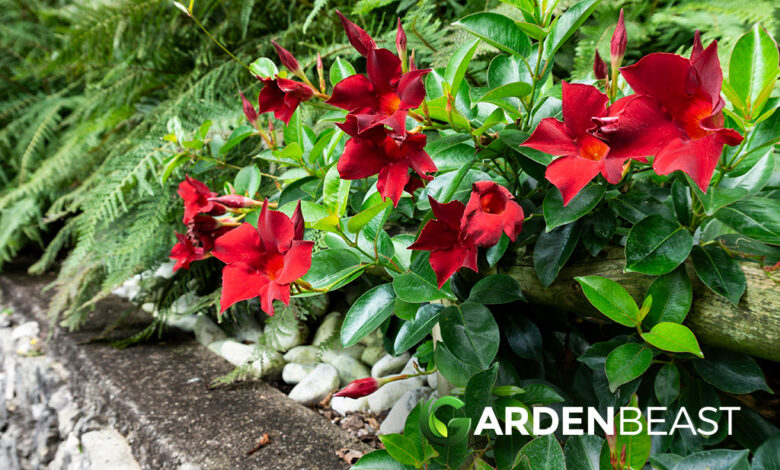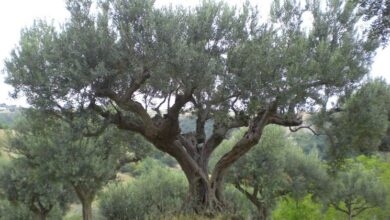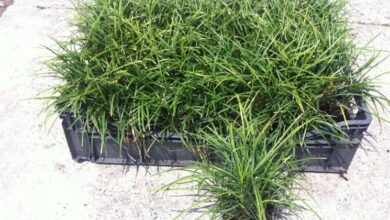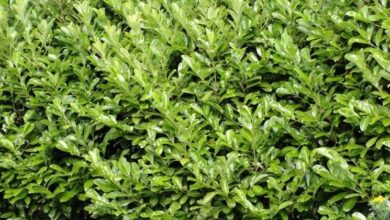Dipladenia (Mandevilla) – Characteristics and care

The dipladenia plant , also known as «mandevilla dipladenia», due to its belonging to the genus of Mandevilla creepers, is native to Latin America and stands out for its beautiful flowering.
There are many people who consider buying a dipladenia, however, we must know that it is a plant that is sensitive to cold , so paying attention to its care will be essential.
In Friends of Gardening we will do a general review so that you can discover everything about dipladenia : care, pruning, watering, diseases … If we are constant in certain details we will make this plant survive and offer us a long and exuberant flowering.

Dipladenia taxonomy
| Kingdom: Plantae |
| Division: Magnoliophyta |
| Class: Magnoliopsida |
| Order: Gentianales |
| Family: Apocynaceae |
| Tribe: Mesechiteae |
| Genus: Mandevilla |
Dipladenia characteristics
If you are considering buying a dipladenia but you have doubts, we advise you to previously inform yourself about the characteristics of the dipladenia plant, because in addition to the care it will need, the plant requires a specific location to develop well, which may not fit in all gardens.
As we have told you in the introduction, dipladenia is also known by its botanical genus, Mandevilla , and belongs to the Apocynaceae family .
Dipladenia can reach over 10 meters in height in its natural habitat and stands out mainly for its flowering , which can last up to three months, from summer to autumn. Dipladenia flowers are trumpet-shaped and can be red, white, yellow, or pink . They can reach between five and new centimeters in thickness, which is why they are considered so exuberant. They offer a subtle perfume and are especially pretty.
On the other hand, the dipladenia plant, which is considered a perennial shrub, offers a very intense dark green foliage , which will accompany us all year round and which, at the same time, will cover the woody stems of this climbing shrub.
Next we will mention some types of dipladenias :
- Dipladenia jamesonii (Mandevilla jamesonii)
- Dipladenia boliviensis ( Mandevilla boliviensis )
- Dipladenia sanderi ( Mandevilla sanderi )
- Dipladenia brachysiphon ( Mandevilla brachysiphon )
- Dipladenia splendens ( Mandevilla splendens )
- Dipladenia equatorialis (Mandevilla equatorialis)
- Dipladenia laxa (Mandevilla suaveolens)

Habitat and distribution of dipladenia
We can find it in various countries in Latin America, specifically in tropical and subtropical areas, such as Brazil and Mexico .
Dipladenia care
If the temperature of our environment does not drop below 10ºC we can place our dipladenia plant outside, on the contrary, if the minimum temperatures are lower, the ideal thing will be to have it in a pot and store it inside when the cold arrives.
We will place it in a well-lit area, preferably in semi-shade , avoiding at the same time drafts.
We will water the plant three times a week , except in winter, when we will water it only once a week. We will avoid at all times that the earth is dry, but at the same time we will avoid waterlogging, therefore the soil must be well drained .
It is advisable to fertilize the plant regularly, every one or two months . There are many types of organic fertilizers that we can use and we recommend rotating several of them to take advantage of all their qualities. This allows us to maintain the good health of the plant.
We can prune dipladenia during the growing seasons, in spring and summer . We will remove the withered leaves, the dry leaves and the weak branches. On the other hand, we will also cut excessively long branches that protrude, which we can use to make cuttings and thus multiply our plant. Here’s how to do it.

Reproduction by dipladenia cuttings
We can reproduce the dipladenia plant by multiplication by cuttings , a simple and easy technique to carry out. It must be done before flowering, during spring, and we must use a clean knife in good condition.
We will prepare a pot with well-fertilized soil mixed with small stones, a great way to recreate the natural substrate that Mandevilla requires. We will press lightly and wet the earth , without causing puddles.
We will cut cuttings between 5 and 8 centimeters and we will place them in the center of the pot. To stimulate the growth of dipladenia plant we can use rooting hormones, available in any garden center.
We will place the pot in a particularly warm area of the home, above 25ºC and cover it with a plastic , however, on a daily basis we must remove the plastic to remove the accumulated water and thus avoid excess humidity.
We can remove the plastic permanently when the first cuttings appear, maintaining the temperature and watering moderately. When the cuttings are bigger and stronger we can place them in a larger pot , adding the same type of substrate.
Dipladenia care in winter
As we have explained throughout the article, the cold affects the dipladenia plant in a very negative way, in fact, it can kill it if it has to endure low temperatures for a long time.
There are many tricks that we can follow, from watering with warm water to covering the plant with plastic to keep it warm. In the latter case we must aerate the plant on a daily basis to avoid excess humidity. We can also slightly isolate the plant from the environment with the use of mulching , also known as mulch or mulch. It consists of covering the soil of the pot with organic matter, such as bark.

Dipladenia diseases
As with all plants, Dipladenia or Mandevilla is susceptible to some diseases or the parasitization of certain insects. Here are the most common diseases of dipladenia:
- Red spider : this insect usually appears during the hottest times of the year and, if it is not treated in time, it can cause our plant to die. Red spider colonies multiply rapidly on the underside of leaves. Depending on the severity of the case, we will proceed to treat with natural remedies or with specific ecological insecticides.
- Cottony mealybug: Also known as mealybug and white, this small white parasite is easy to remove from the plant by using gauze and cotton. We can carry out a manual cleaning while we apply a natural insecticide to prevent the development of the larvae and try to finish the adult specimens. In the most serious cases we will bet on specific products that help us fight the cottony mealybug.
- Mites : we can easily detect the presence of mites when we observe small yellow spots, bumps and yellow leaves all over the plant. Sometimes we can also observe small cobwebs. Once again we are facing a very aggressive parasite, which should be treated with specific products when the infestation is severe.
- Dipladenia with fallen leaves : we can observe various symptoms, such as fallen leaves and dark colors, with a brownish appearance. It is generally due to excess sun or lack of watering, that is, the fallen leaves in dipladenia are due to lack of hydration.
- Dipladenia with yellow leaves : if the substrate does not provide all the nutrients to our dipladenia, we will observe the appearance of yellow leaves . It is usually due to a lack of iron or nitrogen. However, yellow leaves can also be an indication of excess sun and/ or water. We must check that the care offered is adequate.
- Dipladenia does not flower : it is usually accompanied by yellow leaves and is generally due to a bad location. We will check if the hours of sun and shade are adequate. Once again we will review the fact of correctly complying with the care.
Curiosities about dipladenia
This plant is commonly used as an additive in the consumption of ayahuasca , however, there are no obvious studies that demonstrate its possible psychoactive effects. On the other hand, a study carried out by Dr. Alice B. Russell at North Carolina State University indicates that dipladenia is considered a toxic plant, in the publication » Poisonous Plants of North Carolina «.

SEE MORE PLANT SHEETS




